The Role of Reflection and Spirituality in Nursing Practice
VerifiedAdded on 2021/04/21
|6
|1206
|138
Essay
AI Summary
This essay delves into the critical concepts of reflection and spirituality within the nursing profession. It defines spirituality and its diverse meanings, particularly in healthcare settings, emphasizing its significance in helping patients, especially the elderly, find meaning and peace. The essay highlights the positive impact of spiritual care on nursing practices and classifies spiritual guidelines into religious and non-religious interventions. It also discusses reflective teaching methods used in nursing education to bridge the gap between theory and practice. Furthermore, the essay explores two prominent nursing models: Johnson’s Behavioral Systems Model, which focuses on patient behavior to prevent illness, and Neuman’s System Model, which takes a system-based approach to care, considering individual, family, and community factors. The essay references various studies that support the importance of spiritual care and the effectiveness of these models in improving patient outcomes.
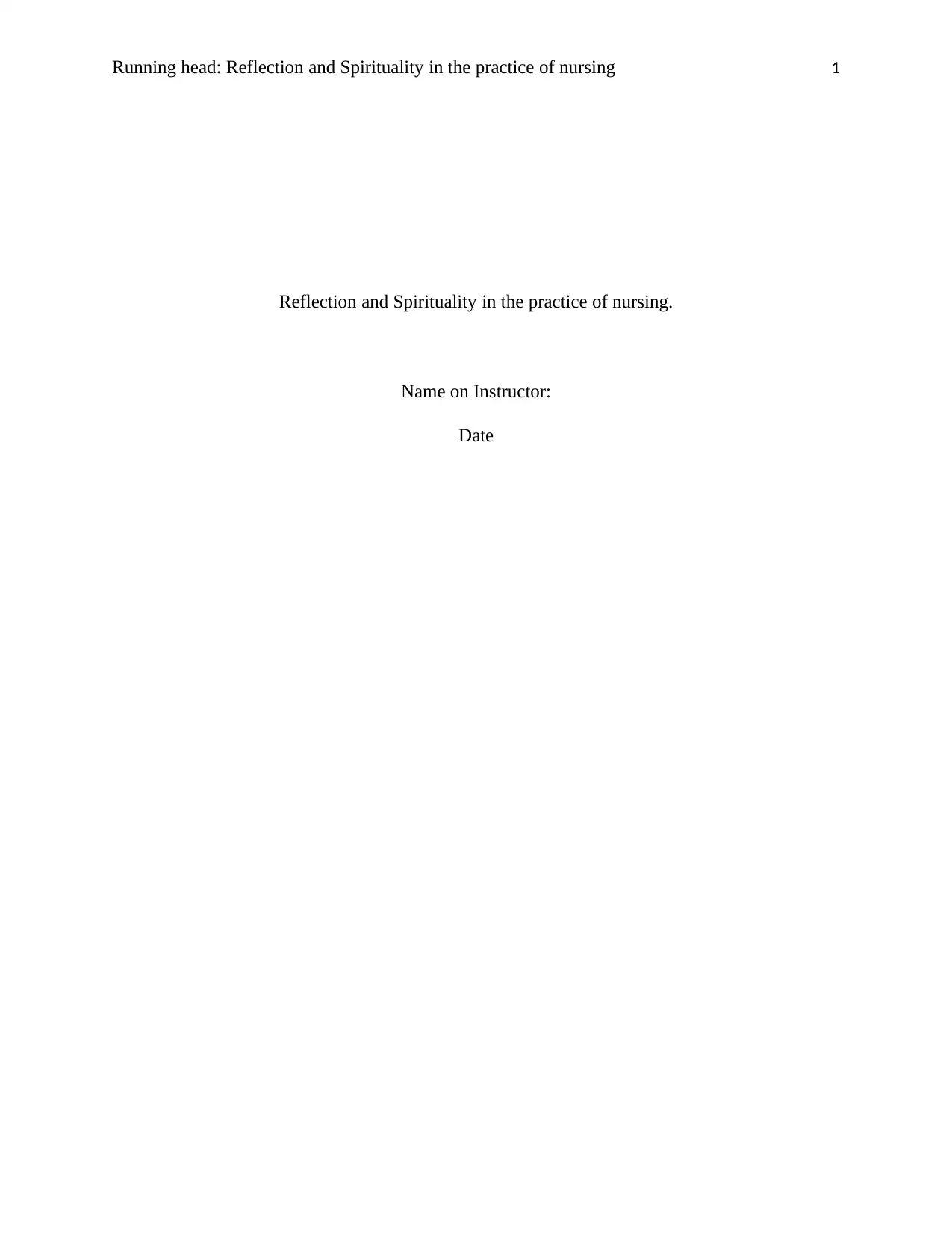
Running head: Reflection and Spirituality in the practice of nursing 1
Reflection and Spirituality in the practice of nursing.
Name on Instructor:
Date
Reflection and Spirituality in the practice of nursing.
Name on Instructor:
Date
Paraphrase This Document
Need a fresh take? Get an instant paraphrase of this document with our AI Paraphraser
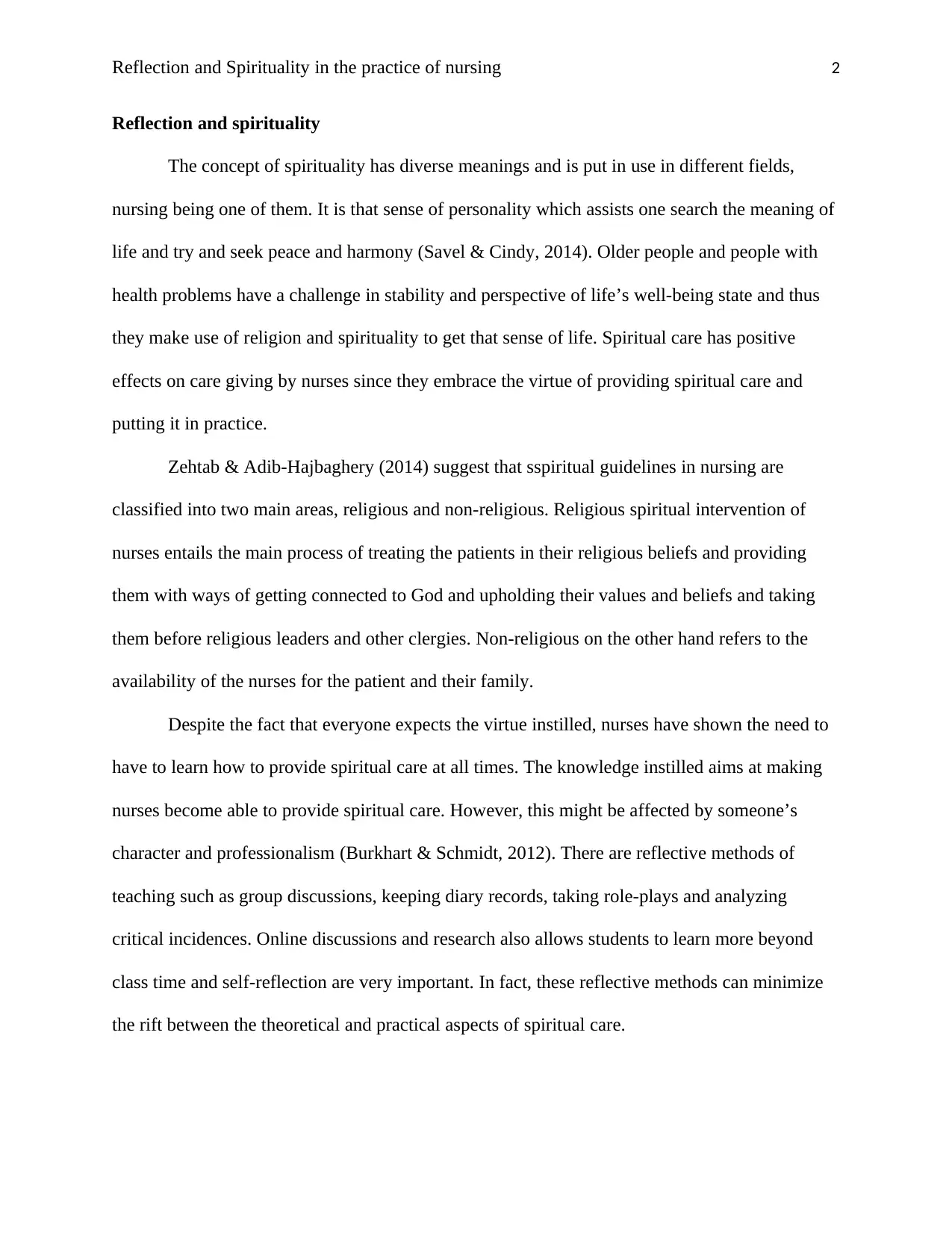
Reflection and Spirituality in the practice of nursing 2
Reflection and spirituality
The concept of spirituality has diverse meanings and is put in use in different fields,
nursing being one of them. It is that sense of personality which assists one search the meaning of
life and try and seek peace and harmony (Savel & Cindy, 2014). Older people and people with
health problems have a challenge in stability and perspective of life’s well-being state and thus
they make use of religion and spirituality to get that sense of life. Spiritual care has positive
effects on care giving by nurses since they embrace the virtue of providing spiritual care and
putting it in practice.
Zehtab & Adib-Hajbaghery (2014) suggest that sspiritual guidelines in nursing are
classified into two main areas, religious and non-religious. Religious spiritual intervention of
nurses entails the main process of treating the patients in their religious beliefs and providing
them with ways of getting connected to God and upholding their values and beliefs and taking
them before religious leaders and other clergies. Non-religious on the other hand refers to the
availability of the nurses for the patient and their family.
Despite the fact that everyone expects the virtue instilled, nurses have shown the need to
have to learn how to provide spiritual care at all times. The knowledge instilled aims at making
nurses become able to provide spiritual care. However, this might be affected by someone’s
character and professionalism (Burkhart & Schmidt, 2012). There are reflective methods of
teaching such as group discussions, keeping diary records, taking role-plays and analyzing
critical incidences. Online discussions and research also allows students to learn more beyond
class time and self-reflection are very important. In fact, these reflective methods can minimize
the rift between the theoretical and practical aspects of spiritual care.
Reflection and spirituality
The concept of spirituality has diverse meanings and is put in use in different fields,
nursing being one of them. It is that sense of personality which assists one search the meaning of
life and try and seek peace and harmony (Savel & Cindy, 2014). Older people and people with
health problems have a challenge in stability and perspective of life’s well-being state and thus
they make use of religion and spirituality to get that sense of life. Spiritual care has positive
effects on care giving by nurses since they embrace the virtue of providing spiritual care and
putting it in practice.
Zehtab & Adib-Hajbaghery (2014) suggest that sspiritual guidelines in nursing are
classified into two main areas, religious and non-religious. Religious spiritual intervention of
nurses entails the main process of treating the patients in their religious beliefs and providing
them with ways of getting connected to God and upholding their values and beliefs and taking
them before religious leaders and other clergies. Non-religious on the other hand refers to the
availability of the nurses for the patient and their family.
Despite the fact that everyone expects the virtue instilled, nurses have shown the need to
have to learn how to provide spiritual care at all times. The knowledge instilled aims at making
nurses become able to provide spiritual care. However, this might be affected by someone’s
character and professionalism (Burkhart & Schmidt, 2012). There are reflective methods of
teaching such as group discussions, keeping diary records, taking role-plays and analyzing
critical incidences. Online discussions and research also allows students to learn more beyond
class time and self-reflection are very important. In fact, these reflective methods can minimize
the rift between the theoretical and practical aspects of spiritual care.
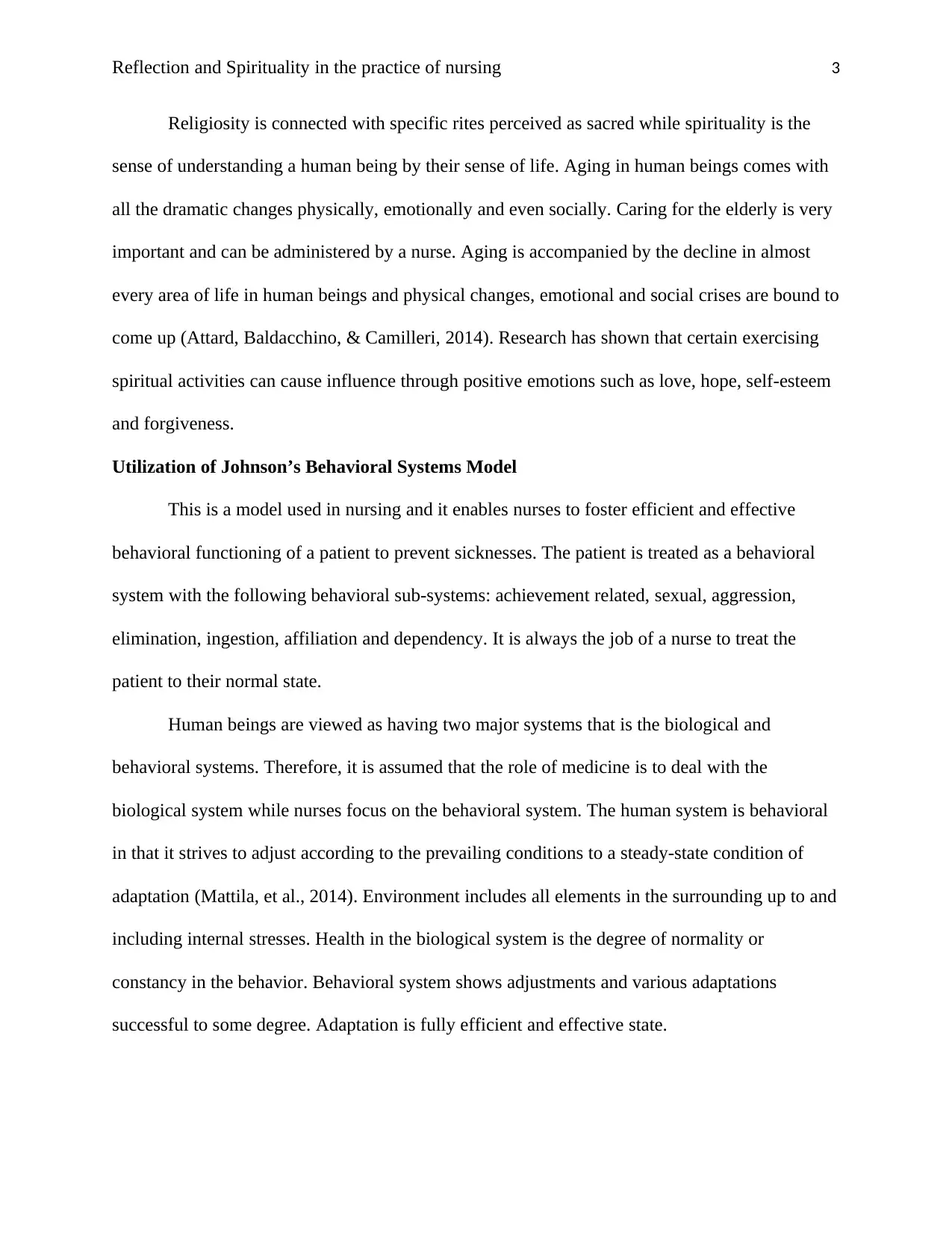
Reflection and Spirituality in the practice of nursing 3
Religiosity is connected with specific rites perceived as sacred while spirituality is the
sense of understanding a human being by their sense of life. Aging in human beings comes with
all the dramatic changes physically, emotionally and even socially. Caring for the elderly is very
important and can be administered by a nurse. Aging is accompanied by the decline in almost
every area of life in human beings and physical changes, emotional and social crises are bound to
come up (Attard, Baldacchino, & Camilleri, 2014). Research has shown that certain exercising
spiritual activities can cause influence through positive emotions such as love, hope, self-esteem
and forgiveness.
Utilization of Johnson’s Behavioral Systems Model
This is a model used in nursing and it enables nurses to foster efficient and effective
behavioral functioning of a patient to prevent sicknesses. The patient is treated as a behavioral
system with the following behavioral sub-systems: achievement related, sexual, aggression,
elimination, ingestion, affiliation and dependency. It is always the job of a nurse to treat the
patient to their normal state.
Human beings are viewed as having two major systems that is the biological and
behavioral systems. Therefore, it is assumed that the role of medicine is to deal with the
biological system while nurses focus on the behavioral system. The human system is behavioral
in that it strives to adjust according to the prevailing conditions to a steady-state condition of
adaptation (Mattila, et al., 2014). Environment includes all elements in the surrounding up to and
including internal stresses. Health in the biological system is the degree of normality or
constancy in the behavior. Behavioral system shows adjustments and various adaptations
successful to some degree. Adaptation is fully efficient and effective state.
Religiosity is connected with specific rites perceived as sacred while spirituality is the
sense of understanding a human being by their sense of life. Aging in human beings comes with
all the dramatic changes physically, emotionally and even socially. Caring for the elderly is very
important and can be administered by a nurse. Aging is accompanied by the decline in almost
every area of life in human beings and physical changes, emotional and social crises are bound to
come up (Attard, Baldacchino, & Camilleri, 2014). Research has shown that certain exercising
spiritual activities can cause influence through positive emotions such as love, hope, self-esteem
and forgiveness.
Utilization of Johnson’s Behavioral Systems Model
This is a model used in nursing and it enables nurses to foster efficient and effective
behavioral functioning of a patient to prevent sicknesses. The patient is treated as a behavioral
system with the following behavioral sub-systems: achievement related, sexual, aggression,
elimination, ingestion, affiliation and dependency. It is always the job of a nurse to treat the
patient to their normal state.
Human beings are viewed as having two major systems that is the biological and
behavioral systems. Therefore, it is assumed that the role of medicine is to deal with the
biological system while nurses focus on the behavioral system. The human system is behavioral
in that it strives to adjust according to the prevailing conditions to a steady-state condition of
adaptation (Mattila, et al., 2014). Environment includes all elements in the surrounding up to and
including internal stresses. Health in the biological system is the degree of normality or
constancy in the behavior. Behavioral system shows adjustments and various adaptations
successful to some degree. Adaptation is fully efficient and effective state.
⊘ This is a preview!⊘
Do you want full access?
Subscribe today to unlock all pages.

Trusted by 1+ million students worldwide
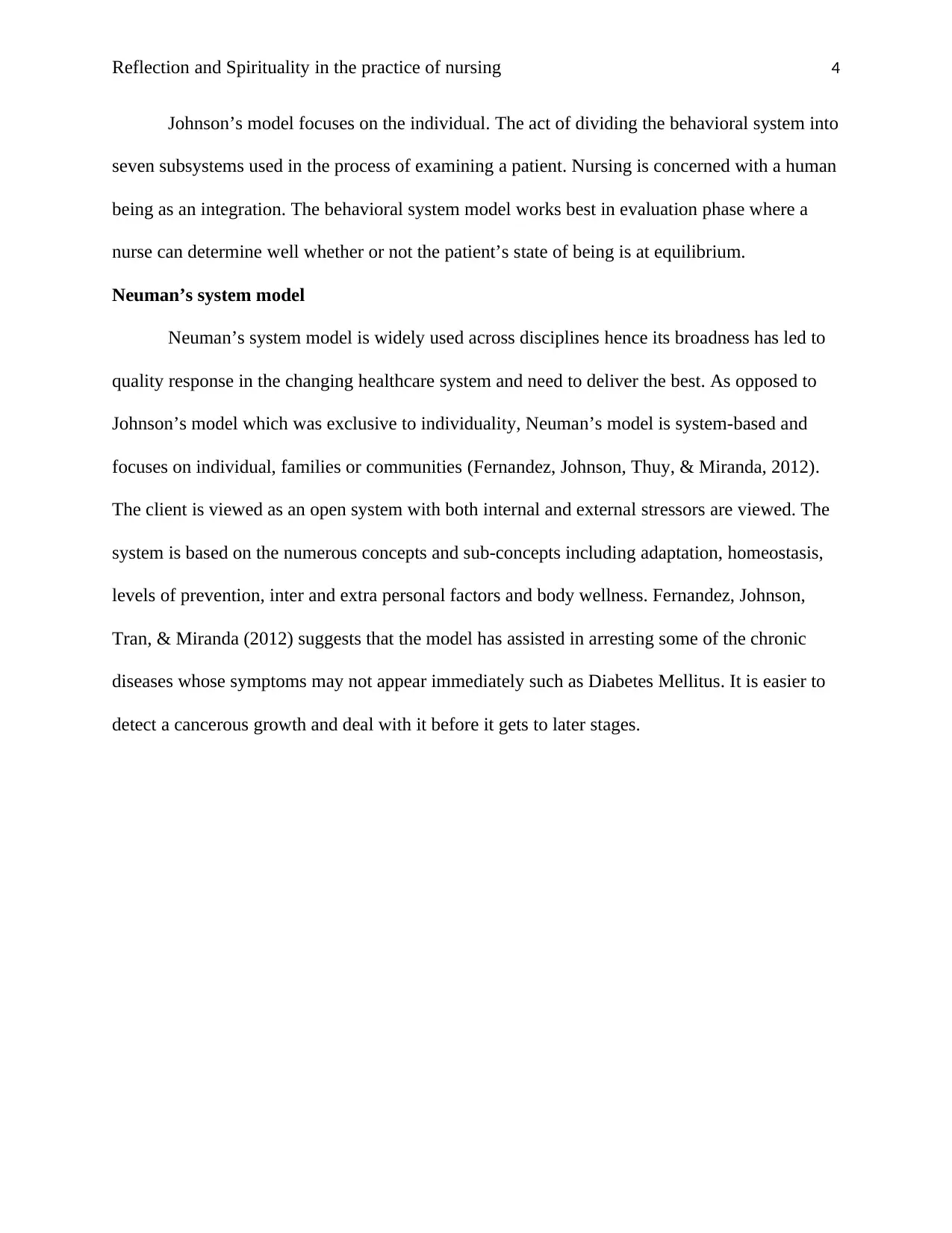
Reflection and Spirituality in the practice of nursing 4
Johnson’s model focuses on the individual. The act of dividing the behavioral system into
seven subsystems used in the process of examining a patient. Nursing is concerned with a human
being as an integration. The behavioral system model works best in evaluation phase where a
nurse can determine well whether or not the patient’s state of being is at equilibrium.
Neuman’s system model
Neuman’s system model is widely used across disciplines hence its broadness has led to
quality response in the changing healthcare system and need to deliver the best. As opposed to
Johnson’s model which was exclusive to individuality, Neuman’s model is system-based and
focuses on individual, families or communities (Fernandez, Johnson, Thuy, & Miranda, 2012).
The client is viewed as an open system with both internal and external stressors are viewed. The
system is based on the numerous concepts and sub-concepts including adaptation, homeostasis,
levels of prevention, inter and extra personal factors and body wellness. Fernandez, Johnson,
Tran, & Miranda (2012) suggests that the model has assisted in arresting some of the chronic
diseases whose symptoms may not appear immediately such as Diabetes Mellitus. It is easier to
detect a cancerous growth and deal with it before it gets to later stages.
Johnson’s model focuses on the individual. The act of dividing the behavioral system into
seven subsystems used in the process of examining a patient. Nursing is concerned with a human
being as an integration. The behavioral system model works best in evaluation phase where a
nurse can determine well whether or not the patient’s state of being is at equilibrium.
Neuman’s system model
Neuman’s system model is widely used across disciplines hence its broadness has led to
quality response in the changing healthcare system and need to deliver the best. As opposed to
Johnson’s model which was exclusive to individuality, Neuman’s model is system-based and
focuses on individual, families or communities (Fernandez, Johnson, Thuy, & Miranda, 2012).
The client is viewed as an open system with both internal and external stressors are viewed. The
system is based on the numerous concepts and sub-concepts including adaptation, homeostasis,
levels of prevention, inter and extra personal factors and body wellness. Fernandez, Johnson,
Tran, & Miranda (2012) suggests that the model has assisted in arresting some of the chronic
diseases whose symptoms may not appear immediately such as Diabetes Mellitus. It is easier to
detect a cancerous growth and deal with it before it gets to later stages.
Paraphrase This Document
Need a fresh take? Get an instant paraphrase of this document with our AI Paraphraser

Reflection and Spirituality in the practice of nursing 5
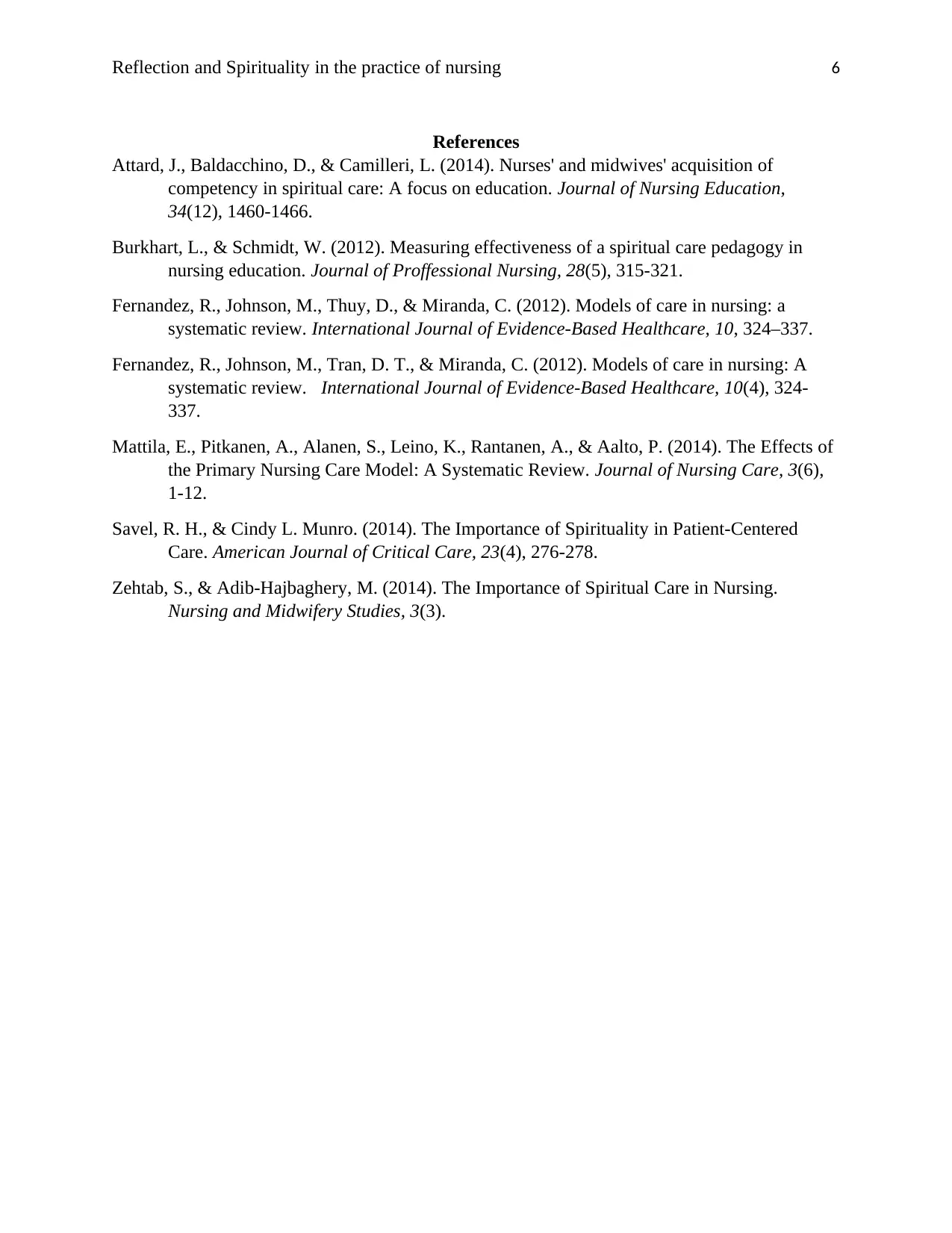
Reflection and Spirituality in the practice of nursing 6
References
Attard, J., Baldacchino, D., & Camilleri, L. (2014). Nurses' and midwives' acquisition of
competency in spiritual care: A focus on education. Journal of Nursing Education,
34(12), 1460-1466.
Burkhart, L., & Schmidt, W. (2012). Measuring effectiveness of a spiritual care pedagogy in
nursing education. Journal of Proffessional Nursing, 28(5), 315-321.
Fernandez, R., Johnson, M., Thuy, D., & Miranda, C. (2012). Models of care in nursing: a
systematic review. International Journal of Evidence-Based Healthcare, 10, 324–337.
Fernandez, R., Johnson, M., Tran, D. T., & Miranda, C. (2012). Models of care in nursing: A
systematic review. International Journal of Evidence-Based Healthcare, 10(4), 324-
337.
Mattila, E., Pitkanen, A., Alanen, S., Leino, K., Rantanen, A., & Aalto, P. (2014). The Effects of
the Primary Nursing Care Model: A Systematic Review. Journal of Nursing Care, 3(6),
1-12.
Savel, R. H., & Cindy L. Munro. (2014). The Importance of Spirituality in Patient-Centered
Care. American Journal of Critical Care, 23(4), 276-278.
Zehtab, S., & Adib-Hajbaghery, M. (2014). The Importance of Spiritual Care in Nursing.
Nursing and Midwifery Studies, 3(3).
References
Attard, J., Baldacchino, D., & Camilleri, L. (2014). Nurses' and midwives' acquisition of
competency in spiritual care: A focus on education. Journal of Nursing Education,
34(12), 1460-1466.
Burkhart, L., & Schmidt, W. (2012). Measuring effectiveness of a spiritual care pedagogy in
nursing education. Journal of Proffessional Nursing, 28(5), 315-321.
Fernandez, R., Johnson, M., Thuy, D., & Miranda, C. (2012). Models of care in nursing: a
systematic review. International Journal of Evidence-Based Healthcare, 10, 324–337.
Fernandez, R., Johnson, M., Tran, D. T., & Miranda, C. (2012). Models of care in nursing: A
systematic review. International Journal of Evidence-Based Healthcare, 10(4), 324-
337.
Mattila, E., Pitkanen, A., Alanen, S., Leino, K., Rantanen, A., & Aalto, P. (2014). The Effects of
the Primary Nursing Care Model: A Systematic Review. Journal of Nursing Care, 3(6),
1-12.
Savel, R. H., & Cindy L. Munro. (2014). The Importance of Spirituality in Patient-Centered
Care. American Journal of Critical Care, 23(4), 276-278.
Zehtab, S., & Adib-Hajbaghery, M. (2014). The Importance of Spiritual Care in Nursing.
Nursing and Midwifery Studies, 3(3).
⊘ This is a preview!⊘
Do you want full access?
Subscribe today to unlock all pages.

Trusted by 1+ million students worldwide
1 out of 6
Related Documents
Your All-in-One AI-Powered Toolkit for Academic Success.
+13062052269
info@desklib.com
Available 24*7 on WhatsApp / Email
![[object Object]](/_next/static/media/star-bottom.7253800d.svg)
Unlock your academic potential
Copyright © 2020–2025 A2Z Services. All Rights Reserved. Developed and managed by ZUCOL.




